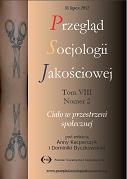„Ciało świątynią duszy”, czyli o procesie budowania tożsamości praktykującego hatha-jogę. Konstruowanie prywatnej quasi-religii
“Body as the temple of the soul” – the process of building the identity of hatha-yoga practitioner. Constructing a private quasi-religion
Author(s): Krzysztof T. KoneckiSubject(s): Social Sciences
Published by: Uniwersytet Łódzki - Wydział Ekonomiczno-Socjologiczny
Keywords: body; corporeality; yoga; hatha-yoga; yoga practice; religion; quasi-religion; para-religion; identity construction
Summary/Abstract: The article addresses the problem of perceiving and experiencing one’s body within the yoga practice. The process of becoming a yogi is related to the practices of the body and to further defining them; next, to the defined perception of the body and its sensations. Becoming a hatha-yoga practitioner is a specific process. In this paper I describe its phases: 1. The introductory phase – constructing the motives and first steps; 2. Phase of the deeper recognition of psycho-physical effects of yoga practice and of attributing them with adequate meanings; 3. Phase of the deeper recognition of hatha-yoga spiritual aspects (quasi-religion). At the moment of significant involvement in hatha-yoga practice and defining corporeal practices in terms of being bodily and mental at the same time, the mind – body rapport compound. The work over the body may transform the Western perspective of defining the body as a substantial element of human existence (Cartesian vision) into treating it as a spiritualized matter (vision of Eastern philosophy). If, however, the tenets of other religions are maintained as one’s own (e.g., catholic religion), the transformation at hand will not proceed. In that case, in order to reconcile the conventional religion tenets with new spiritual experiences, changes in body and mind need to be defined in any other way, and a specific linguistic explanations of these changes (often adopting the scheme of constant linguistic formulas) need to occur.
Journal: Przegląd Socjologii Jakościowej
- Issue Year: VIII/2012
- Issue No: 2
- Page Range: 64-111
- Page Count: 48
- Language: Polish

